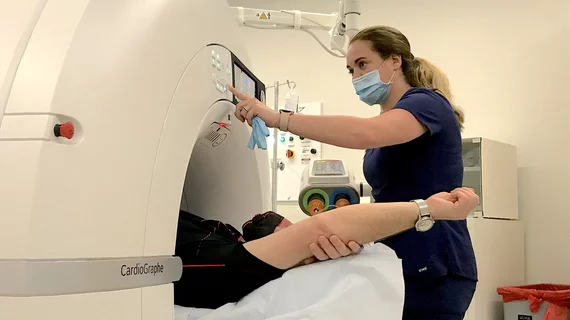Academic radiology operation takes less than a week to cut contrast consumption in half
Another teaching hospital has quickly and safely reduced its reliance on iodinated contrast media (ICM) by around 50% and taken to the pages of JACR to tell how they did it.
Like their peers at UNC Health in Chapel Hill, the radiologists who led an institution-wide response to the Omnipaque (iohexol) shortage at Vanderbilt University Medical Center (VUMC) in Nashville developed situation-specific strategies on crisis mitigation, communication, prioritization and procurement.
Additionally, both teams adapted lessons learned from firsthand experiences with, and secondhand accounts of, the COVID pandemic.
Each team gives a nod to the American College of Radiology for issuing helpful guidance on dealing with the shortage. In Vanderbilt Radiology’s case, the team reports that it had its plan in place ahead of the ACR document’s arrival on May 13.
In fact, the department began preparing soon after China’s government began locking down Shanghai due to a COVID outbreak on March 31, forcing GE Healthcare to cease production of Omnipaque at its plant in that city.
Later, when GE warned its Omnipaque clients to expect an 80% reduction in order fulfillment lasting six to eight weeks, the Vanderbilt team “identified a reserve of seven to 10 days of ICM on hand,” Laveil Allen, MD, and colleagues recall in the JACR case study [1], which went online May 18.
This estimate of total contrast reserves, they explain, was “based on inventory and average weekly contrast usage rates. … The VUMC Department of Radiology and Radiological Sciences immediately recognized that extraordinary steps would be needed to conserve the remaining supply of ICM.”
With that, Omary and co-authors flesh out the details of their response under a set of five discrete but interrelated steps, framed as imperatives:
Step 1: Establish a Radiology Command Center
Step 2: Develop Contrast Mitigation Strategies
Step 3: Develop Contrast Exhaustion Risk (CER) and Tiering System for Outpatient Imaging
Step 4: Centralize Outpatient Contrasted CT Orders
Step 5: Communicate Across Health System
Omary et al. report:
The combined strategy of setting up a radiology command center team, forming multidisciplinary partnerships and implementing contrast mitigation tactics successfully reduced contrast usage by about 50% in less than seven days. In the setting of a global ICM shortage, these results preserve contrast for the most critically ill patients.”
The team wrap their report with a hat tip to “clinicians across our entire health system who altered their practices to reserve ICM for patients most in need.”
JACR has posted the paper in full for free.
More Coverage of the Omnipaque Shortage:
6 categories of contrast CT prove ripe for revisiting during supply shortage
GE provides update on contrast media shortage
AHA presses GE for a detailed progress report on CT contrast shortage
Frontline perspectives on the CT contrast shortage: 5 notable quotes
Preserving contrast media supplies: 7 ACR recommendations
Be prepared: IV contrast media shortage could last up to 8 weeks
Reference:
- Laveil M. Allen, L. Taylor Davis, Brent Savoie, Katherine Frederick-Dyer, LeAnn Stokes, Sumit Pruthi, Joanna Shechtel, Sarah Allen, Sheryl Redlin Frazier, Cameron Henry, Reed A. Omary, “Rapid Response to the Acute Iodinated Contrast Shortage During the COVID-19 Pandemic: Single Institution Experience.” Journal of the American College of Radiology, May 18, 2022. DOI: https://doi.org/10.1016/j.jacr.2022.05.005

